Shopify vs Wix: Which Platform is Right for Your Business?
Introduction
In 2022, global ecommerce sales reached a whopping total of $5.7 trillion. As ecommerce is a lucrative industry, every day, many businesses are joining the race. To thrive sooner and faster in this ecommerce world, you need to seek the best platform to showcase your products and services online first.
So now you’re considering two of the most popular platforms in the market: Shopify and Wix. You want to know which one is really for your business.
In this blog post, we will provide a comprehensive comparison of these two giants in terms of their features, functionality, and performance. Whether you are a small business owner or an established brand, in the end, you’ll be able to know which platform is the best fit for your ecommerce needs.
Shopify vs Wix: Quick comparison
Statistics show that both Shopify and Wix are currently the two biggest giant ecommerce platforms. So, what are they?
What is Shopify?
Shopify is an all-in-one platform that provides ecommerce tools for business owners to create an online store quickly and easily. According to BuiltWith, Shopify powers almost 4.6 million ecommerce stores, accounting for nearly 15% of the ecommerce usage distribution on the entire Internet.

What is Wix?
Wix is a website building platform that enables you to create a website for various purposes, including ecommerce websites, without any coding or technical knowledge. Over time, Wix has evolved to be one of the most ecommerce platforms. Today Wix as an ecommerce platform is just as popular as Shopify, powering more than 4.4 million ecommerce sites (14% of the ecommerce usage distribution on the entire Internet).

The market share in 2023 of Shopify and Wix:
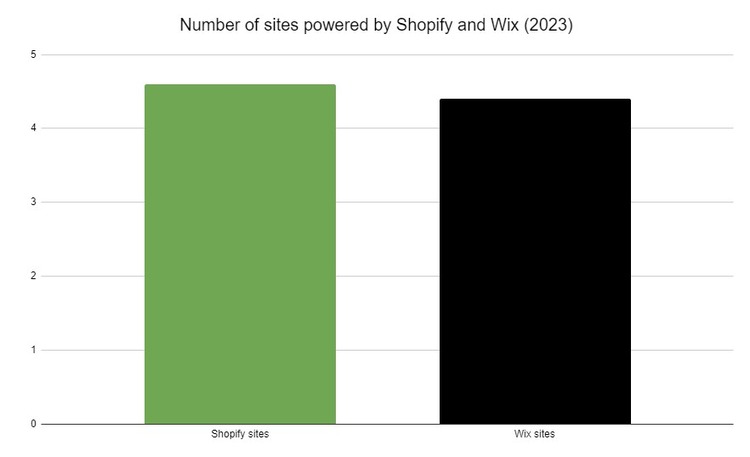
Can I sell products on Wix?
Absolutely yes, you can sell products on Wix. Though initially a website builder, today, Wix offers a comprehensive ecommerce platform that allows millions of businesses to create an online store and sell their products.
What is the key difference between Wix and Shopify?
The key difference between Wix and Shopify lies in their nature. Shopify is built for ecommerce purposes, whereas Wix was initially built as a website builder and now offers ecommerce functionality. That means Shopify offers a wider range of features and tools specifically designed for online stores, such as ecommerce-focused themes and templates, advanced features for dropshipping, etc. In contrast, Wix’s ecommerce features are more limited, and it does not offer the same level of customization and functionality as Shopify.
Shopify vs Wix: Table Comparison
| Criteria | Shopify | Wix | Winner |
|---|---|---|---|
| Pricing | Monthly plans starting from $39 per month. Fees for credit card transactions range from 2.4% to 2.9% + 30¢ + 0.5–2% per transaction. | Monthly plans starting from $27 per month. Fees for credit card transactions from 2.9% + 30¢ per transaction. | Wix |
| Sales Features | Offers a wide range of sales features, including abandoned cart recovery, discount codes, and gift cards. | Offers basic sales features, including discount codes and abandoned cart recovery. | Shopify |
| Dropshipping | Integrates with popular and more dropshipping apps. | Offers integrations with a few dropshipping apps. | Shopify |
| SEO & Marketing | Offers built-in SEO features and integrations with popular marketing tools like Mailchimp and Google Analytics. | Offers built-in SEO features and integrations with popular marketing tools like Google Analytics and Facebook Ads. | Shopify |
| Help & Support | Offers 24/7 customer support via live chat, email, phone and social media. Also has a vast knowledge base and community forum. | Offers 24/7 customer support via phone, email and social media. Also has a knowledge base and community forum. | Tie |
| Page Speed | Offers fast page load times and optimized mobile experience. | Offers relatively fast page load times but less optimized mobile experience. | Shopify |
| Third-party apps | Offers a wide range of third-party apps and integrations in the Shopify App Store. | Offers a decent selection of third-party apps in the Wix App Market. | Shopify |
| Security | Offers high-level security with SSL encryption, fraud analysis, and PCI compliance. | Offers standard security measures with SSL encryption and PCI compliance. | Shopify |
| Ease of Use | Offers a user-friendly interface and easy-to-use store builder. | Offers a user-friendly interface and drag-and-drop store builder. | Shopify |
| Themes and Templates | Offers a vast selection of high-quality, customizable themes in the Shopify Theme Store. | Offers a good selection of customizable templates. | Shopify |
From the table, we can basically see that:
Shopify is better than Wix because:
- Advanced ecommerce features: Shopify is specifically designed for ecommerce and offers a wide range of advanced ecommerce features such as abandoned cart recovery, gift cards, and multi-channel selling.
- Strong app ecosystem: Shopify has a robust app store with over 8,000 apps, providing users with a wide range of customization options and additional features.
- Better for scaling: Shopify is better suited for businesses that plan to scale, thanks to its advanced features and ability to handle high-volume sales.
Wix is better than Shopify because:
- More affordable: Wix pricing plans are more affordable than Shopify pricing plans, making it a more attractive option for smaller businesses or those just starting out.
- No transaction fees: Wix doesn’t charge transaction fees on sales made through its platform, while Shopify does if merchants don’t use Shopify Payments.
- User-friendly website builder: Wix and Shopify are easy to use, but Wix is even easier for users with no coding experience to create an ecommerce site quickly.
- All-in-one platform: Wix offers more than just ecommerce features, allowing users to build a complete online presence, including a blog, portfolio, and other pages.
Shopify vs Wix: In-depth Comparison
Pricing
Subscription fees
Shopify Pricing Plans
Shopify offers 5 pricing plans in total:
- Shopify Starter Plan: 5$ per month
- Shopify Basic Plan: $39 per month
- Shopify Plan: $105 per month
- Shopify Advanced Plan: $399 per month
- Shopify Plus: Custom (from $2,000 per month)

There are only three main subscription plans (Basic Plan, Shopify Plan, and Advanced Shopify Plan). Shopify Starter Plan just gives users a lite version that has the checkout feature. Meanwhile, Shopify Plus is the enterprise-level plan for high-volume businesses.
If you’re considering Shopify, you can start a 3-day free trial to experience this platform.
You can pay the upfront fee monthly or annually. It is much cheaper when you pay annually.
- Basic Plan: $29 per month (annual plan)
- Shopify Plan: $79 per month (annual plan)
- Advanced Shopify Plan: $299 per month (annual plan)
What makes the difference between Shopify pricing plans is the availability of features in the higher-level plans, including:
| Basic Plan | Shopify Plan | Advanced Plan | |
|---|---|---|---|
| Staff accounts | 2 | 5 | 15 |
| Reports and Analytics | Basic | Standard | Advanced |
| Ecommerce automation(Shopify Flow) | |||
| Duties and import taxes | |||
| Third-party calculated shipping rates |
Wix Pricing Plans
Wix has 3 pricing categories: Website Plans, Business and ecommerce Plans, and Enterprise Plans. Among them, Website Plans are to build a website purely for content, and the other plans are for ecommerce purposes. In this article, we will only talk about the plans for ecommerce purposes.
Wix currently offers 4 ecommerce pricing plans:
- Business Basic: $27 per month
- Business Unlimited: $32 per month
- Business VIP: $59 per month
- Enterprise Plan: Custom
Wix offers a 14-day money-back guarantee, which means that if you sign up and decide to stop using the service within the first 14 days, you can request a refund.

What makes the difference between the Wix pricing plans is the availability of features in the higher-level plans, including:
| Business Basic | Business Unlimited | Business VIP | |
|---|---|---|---|
| Storage space | 50 GB | 100 GB | Unlimited |
| Video hours | 5 hours | 10 hours | Unlimited |
| Customer care | 24/7 customer care | 24/7 customer care | Priority customer care |
| Customized reports |
Though the prices are displayed as per month, Wix indicates that they bill annually—meaning you have to pay a sum of money for 12 months right at the time of purchase.
As Wix only accepts a yearly payment, we will compare the yearly plans of both platforms.
| Low-tier plan (Annual plan) |
Mid-tier plan (Annual plan) |
High-tier Plan (Annual plan) |
|
|---|---|---|---|
| Shopify | $29 / month | $79 / month | $299 / month |
| Wix | $27 / month | $32 / month | $59 / month |
Though the gap between the low-tier plan of Shopify and Wix is not significant, the mid- and high-tier plans on Shopify are way more expensive than Wix.
And yes, Wix is cheaper than Shopify, especially in mid-tier and high-tier plans. However, compared with the advanced features only available on Shopify’s higher-level plans, those on Wix are less outstanding for an ecommerce store.
Note that Shopify and Wix both offer different pricing to merchants in different countries. The numbers above only apply to US sellers. You can click here to see how much Shopify costs and how much Wix costs in your country.
Transaction fees
Shopify Transaction Fees
For Shopify users, you can either choose Shopify Payments (Shopify in-house payment gateway) or third-party payment gateways (other than Shopify Payments).
While Shopify doesn’t charge transaction fees to those using Shopify Payments, it charges 0.5–2% per transaction to those using third-party gateways.
Of course, whether Shopify charges you transaction fees or not, you still have to pay credit card rates, which vary depending on your pricing plan:
- Shopify Basic Plan: 2.9% + 30¢ per online transaction; 2.7% + 0¢ in person
- Shopify Plan: 2.6% + 30¢ per online transaction; 2.5% + 0¢ in person
- Shopify Advanced Plan: 2.4% + 30¢ per online transaction; 2.4% + 0¢ in person
Note that this does not apply to Shopify Starter Plan. Shopify still charges you 5% per transaction whether you use Shopify Payments or not.
Wix Transaction Fees
Unlike Shopify, Wix doesn’t charge transaction fees at all. The only fee you have to pay is the payment processing fee, which varies depending on the payment gateway you use and the region.
For instance:
- Credit card rates for US sellers: 2.9% of the transaction amount + 0.30 USD
- Wix Payments Point of sales (POS) for US sellers: 2.6% + 0 USD
⇒ Regarding transaction fees: Wix or Shopify can be more expensive depending on the payment method you choose. You can avoid transaction fees on Shopify by using Shopify Payments, which makes Shopify potentially cheaper.
Additional fees
To have a basic online website, you need a domain name and hosting.
Wix and Shopify are fully hosted platforms, meaning hosting is included in their pricing packages. And you still have to pay for a domain name separately. The cost for a domain name ranges from $0.99 to $30 per year. The only difference regarding a domain name is that Wix offers a free domain name for the first year, while Shopify gives you a free domain through Shopify (containing “myshopify” in the domain name) until you buy your own domain.
Besides, both platforms offer additional apps that help enhance the store’s functionality. The apps could be free or paid, so you should be well aware that you may have to pay extra money to use advanced tools.
The verdict: Wix wins because of its cheaper upfront costs and maybe cheaper transaction fees.
Can I use Wix and Shopify for free?
Shopify does offer a 3-day free trial, while Wix offers a 14-day refund.
During the trial, Shopify lets you fully use its features and capabilities while Wix limits the functionalities you can use: you can’t sell online or connect a domain to Wix.
Shopify offers a free trial for only 3 days, which is rather short and may not give online businesses enough time to experience the platform. However, it does have another trial program in 3 months for just $1/month. During the free trial, you can actually sell and make money online. You can click here to see this deal.
Sales Features
The capability to sell online must be one of the biggest considerations when you compare the two ecommerce platforms. So, Wix vs Shopify: which is better to sell online?
Both Wix and Shopify offer a variety of tools to help an online business sell physical and digital products. We will compare these notable sales tools between the two platforms to see which platform is the winner.
#1. Payment Options
Wix and Shopify support many payment options. Users of both platforms can pay offline or online with a credit/debit card or other payment gateways, like PayPal.
Shopify has its native payment gateway—Shopify Payments, and so does Wix with its Wix Payments. However, Shopify Payments and Wix Payments are NOT available in all countries, though the countries supported by Shopify are much more than by Wix.
That’s when you’ll need a third-party payment gateway.
Still, Shopify wins when it comes to supported payment gateways. Shopify can support 100+ payment gateways, including all major credit cards, PayPal, and Amazon Pay. It has slightly more payment gateway options compared to Wix. Wix supports 97 payment options, including credit cards, PayPal, and Stripe.
#2. Abandoned Cart Recovery
The abandoned cart recovery feature allows merchants to automatically send up follow-up emails to customers who have abandoned their carts. These emails can include discount codes, product recommendations, and other incentives to encourage the customer to complete the purchase. Merchants can also view a list of abandoned carts and manually send follow-up emails if they want.
Shopify and Wix both offer a built-in abandoned cart recovery feature to help merchants incentivize potential customers to complete their purchases.
#3. Shipping Options
Both platforms offer a similar shipping feature set, including:
- Real-time shipping rates
- Customizable shipping rules
- Multiple shipping options
- Integration with third-party apps through the Shopify app market and Wix app market
- International shipping
- Free shipping
- In-store pickup
However, Shopify has a slight edge as it has more third-party apps as well as its native shipping service called Shopify Shipping. This service helps you avoid extra apps, accounts, or fees.
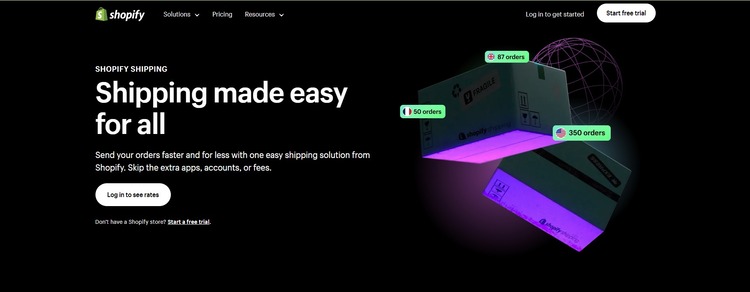
#4. Product Options and Variants
Product options and variants enable online retailers to provide a range of choices to their customers. But before we analyze this feature on Wix and Shopify, it’s good to know what product options and variants exactly are.
Say, your products are T-shirts.
- Product Options are the type of option. For instance, “size” or “color” are product options.
- Product Option Choices are the choices for a product option. For the “Size” option, your choices might be “L” or “M.”
-
Product Variants are the specific item. Now that your product has 2 product options—size and pattern. Each of them has 2 choices: Size (L or M) and Pattern (checked or print). Now you have 4 product variants:
- L - checked
- L - print
- M - checked
- M - print

The difference between Shopify and Wix lies in the limit of product options and product variants.
With Shopify, you can add up to 3 product options and 100 variants to each product. Meanwhile, Wix allows you to add up to 6 product options and 1,000 variants to each product.
However, Shopify still makes up for that by offering paid apps to extend the number of product variants (up to 1,000). Also, Shopify has “conditional logic” functionality, an advanced feature for product option display. This feature allows you to set conditional logic for product options. So certain options can be hidden or shown based on the customer’s previous selections.
#5. Product import and export
Wix and Shopify allow you to import and export product options and variants in bulk using CSV files. This makes it easy to manage a large number of products on both ecommerce platforms. However, while there is no limit to importing and exporting product data on Shopify, Wix limits the number of products you import and export each time (up to 5,000 each time and up to 50,000 products in total).
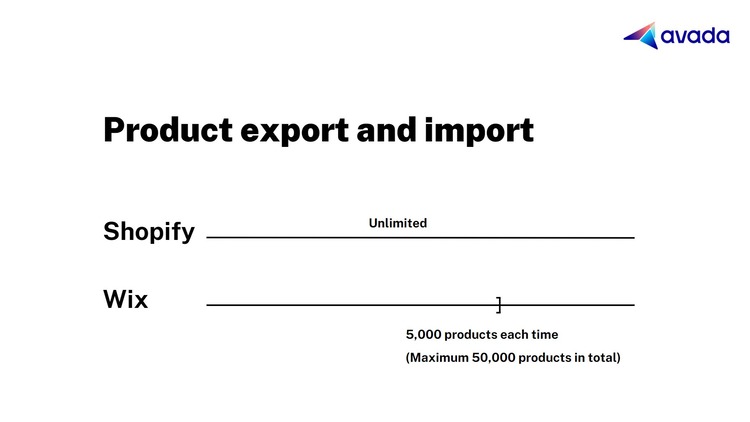
Also, note that Wix doesn’t let you import or export digital products.
In short, Shopify is better than Wix when it comes to importing and exporting product data, especially when you have a large number of products.
#6. Tax setting
Both Wix and Shopify offer essential tax management features, including:
- Tax calculation: Wix and Shopify allow merchants to automatically calculate taxes based on the customer’s location. Shopify also offers a manual tax override option for more customization, while Wix does not.
- Tax exemptions: Shopify allows merchants to set up tax exemptions for specific customers or products. Wix does not have this feature.
- Multi-currency support: Shopify supports over 100 different currencies and automatically calculates taxes in the correct currency based on the customer’s location. Wix does not have multi-currency support.
- Tax reports: Shopify and Wix provide detailed tax reports to help merchants file taxes correctly.
- Integration with tax software: Shopify and Wix integrate with popular tax software like Avalara to automate tax compliance.
- EU VAT compliance: Shopify and Wix automatically detect if a customer is in the EU and calculates VAT based on the customer’s location.
As we can see, Shopify provides greater flexibility in tax calculation, exemption settings, and multi-currency support. However, Wix may still be a suitable option for smaller businesses with more straightforward tax needs.
#7. Point-of-sale (POS) functionality
Merchants can use POS systems to accept payment in person and track inventory online. Both Wix and Shopify have their own built-in POS solution. They are Wix POS and Shopify POS. However, there are several features that make Shopify POS a more ideal solution:
- Integration with Online Store. This allows businesses to manage their online and offline sales from one place and is of course available on both platforms.
- Hardware Compatibility: With Wix, only Wix hardware is supported, so you can’t purchase any other card reader or receipt printer other than their own. Meanwhile, Shopify allows you to use any hardware compatible with Shopify.
- Various Payment Options: Both platforms accept many payment options such as credit cards, debit cards, PayPal, and gift cards. Shopify even accepts split payments while Wix doesn’t.
- Offline Sales Management. This allows businesses to manage offline sales, track inventory, and create customer profiles. This is available in Shopify while unavailable in Wix.
- Analytics and Reporting. With both platforms, you can access robust analytics and reporting features to track sales, inventory, and customer data in real time.
The thing is: Shopify POS supports all the countries where Shopify supports credit card payment providers. Meanwhile, at present, Wix POS is available to merchants only based in Canada and the United States.

Shopify also has Shopify POS app, letting you sell products, customize checkout screens, accept payments, track inventory, set up customer profiles, and more right from the app on the phone.

Shopify POS has two packages: Shopify POS lite and Shopify POS Pro. The lite version is free and included in every Shopify pricing plan. But if you wish to use more advanced features, you may consider using Shopify POS Pro, which costs you an additional $89 per month per location, with these advanced features:
- All Shopify POS Lite features
- Up to 1,000 locations
- Unlimited store staff
- Smart inventory management
- Omnichannel selling features
- Unlimited registers
- Staff roles and permissions
- In-store analytics
Shopify has more advanced POS features. While both platforms offer POS functionality, Shopify provides more comprehensive and advanced features, making it a better choice for businesses with complex offline sales needs.
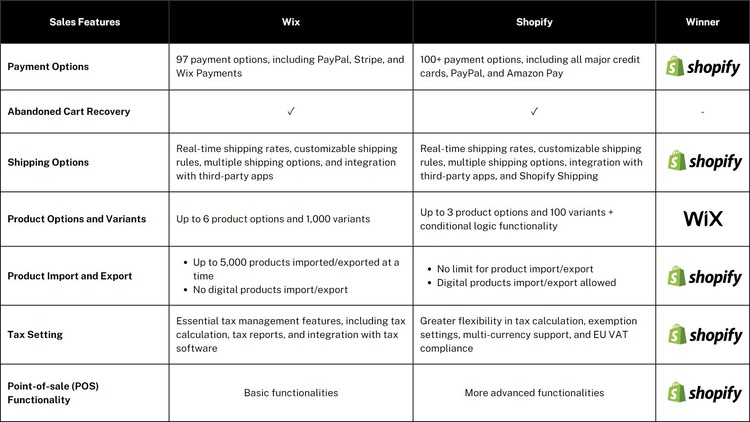
The verdict: Shopify has an advantage over Wix as it has more advanced sales features.
Do Wix and Shopify have discount functionality?
Yes, both Wix and Shopify have discount functionality.
Wix and Shopify allow users to create discounts for their products or services, either by a percentage or a fixed amount. The discount can be set for specific items or for an entire purchase and can be set to expire after a certain date or after a certain number of uses. Both also support free shipping on orders over a certain amount.
Dropshipping
Shopify and Wix both support dropshipping and print-on-demand (POD). You can automate order fulfillment and track updates for dropshipped products, customize the storefront with built-in SEO and marketing tools, manage inventory and order, advanced reporting and analytics tools to track sales and performance, etc.
Plus, both platforms allow you to integrate a number of dropshipping apps, such as Modalyst or Printful. The differences between the two platforms are:
- Shopify supports 400+ dropshipping apps, significantly more than Wix.
- Dropshipping by Modalyst on Wix is not supported on the Business Basic plan. The number of products is limited for the Business Unlimited plan and is only unlimited on the VIP Plan.
The verdict: Shopify offers more options for dropshipping with its extensive integrations with various dropshipping apps and suppliers.
Which is better for dropshipping, Wix or Shopify?
Shopify is generally considered better for dropshipping than Wix because it has more built-in features and apps that cater specifically to dropshipping businesses. Shopify offers a wide range of apps for dropshipping, including inventory management, order fulfillment, and shipping solutions.
Additionally, Shopify has a larger user base and community of dropshipping entrepreneurs, which means there are more resources, tutorials, and support available for dropshipping businesses.
SEO & Marketing Features
Marketing is an indispensable part of your business strategy, as with robust marketing tools, your store can reach more customers and grow faster. But Shopify vs Wix: which platform has better marketing features?
#1. Search Engine Optimization (SEO) features
Wix, initially a website builder as we said, seems to have a slight edge in this area with its built-in advanced features for improving search rankings. You can click here to see all the SEO features Wix offers.
However, Shopify is not lesser. Indeed, Shopify has risen to become a rival even in terms of SEO features, which are supposed to be Wix’s strength.
They both provide the fundamental SEO features:
- Customizable URLs: Both platforms allow you to customize your URLs. However, Shopify provides more flexibility in terms of URL structure, allowing you to optimize your URLs for SEO.
- Meta Tags: Both platforms allow you to edit meta titles and descriptions, but Shopify allows for more control over these tags with the ability to edit canonical tags and noindex/nofollow tags.
- Sitemaps: Both platforms automatically generate sitemaps for your website, but Shopify’s sitemap is more customizable and allows you to include or exclude specific pages.
- Speed and Performance: Site speed is an important factor for SEO, and Shopify has a reputation for faster page load times compared to Wix. This can improve user experience and search engine rankings.
- Mobile Optimization: Both platforms offer mobile optimization, but Shopify themes are designed with mobile responsiveness in mind. This can improve your site’s mobile SEO rankings. This is helpful for SEO because Google’s algorithm prefers responsive and “mobile-first” sites.
- SEO Apps and Plugins: Both platforms offer apps and plugins that can enhance your SEO efforts. However, Shopify has a larger and more diverse app marketplace, giving you more options for SEO optimization.
Overall, we argue that it’s a tie when it comes to comparing the SEO features of Shopify and Wix. Indeed, while Wix has made strides in improving its SEO features, Shopify still has an edge in terms of customizable SEO options, site speed, and mobile optimization.
#2. Email Marketing
Both Shopify and Wix understand the power of email marketing as both invest heavily in delivering email marketing tools. Both have their own app: Wix Email Marketing (also known as Ascend by Wix) and Shopify Email. The highlights of the two email marketing tools are:
- Design branded emails easily.
- Use templates, including customizable templates, drag-and-drop design, and segmentation options, without any coding skills.
- Automate emails quickly.
- Analyze real-time data, allowing an online business to track open rates, click-through rates, and conversion rates.
One unique feature of Shopify Email is the ability to create email campaigns based on customer behavior, such as previous purchases or products viewed. Once you are a Shopify paid user, you can send at most 10,000 emails for free every month with Shopify Email. If you exceed that number, you are charged $0.001 USD per additional email.
Meanwhile, Wix doesn’t make it clear about the number of free emails. They say that the number of emails you can send depends on your monthly balance.
#3. Social Media Integration
Both platforms have social media integration, but Shopify goes beyond the basics. It offers social media sharing buttons on product pages and the ability to create shoppable Instagram posts and social media ads through the Shopify Marketing tool. Wix has social media integration but doesn’t have features as advanced as Shopify.
#4. Product Reviews
Both platforms offer product review apps, which are crucial for building social proof and improving SEO. With Wix, its app Velo by Wix can help you add ratings and reviews to your Wix site. Shopify also provides a native Product Reviews app.
#5. Analytics and Reporting
Both platforms provide analytics and reporting tools, such as traffic and sales data. However, Shopify has more advanced options with its built-in analytics dashboard and third-party reporting tools like Google Analytics. Wix also offers analytics, but it’s rather basic for an ecommerce store.

#6. Blogging features
Wix and Shopify offer built-in blogging capabilities, allowing users to create and publish blog posts. However, Shopify’s blogging capabilities are slightly more limited compared to Wix’s, which offers more customization options. Here are the reasons why:
- SEO for Blog Posts: Both platforms offer SEO tools for optimizing blog posts. Shopify’s SEO tools are relatively basic, whereas Wix offers more advanced SEO features.
- Design Flexibility: Shopify offers more design flexibility when it comes to creating blog posts. Wix, on the other hand, has more limited design options.
- Content Management: Wix has a more intuitive content management system, making it easier for users to organize and manage their blog content. However, it is considered pretty slow by some users. Shopify’s content management system is less flexible, making it harder for users to manage larger amounts of content, yet it is faster and cleaner.
- Social Sharing: Both platforms allow users to easily share blog posts on social media. However, Wix offers more social sharing options, including the ability to add social media buttons to individual blog posts.
It can be said that Shopify, an all-in-one ecommerce platform, invests in aspects, including blogging, to help merchants sell better. Yet, it’s still a few steps behind a website-building platform like Wix regarding blogging capabilities.

The verdict: Shopify is slightly better than Wix regarding overall marketing features.
Which is better for SEO, Wix or Shopify?
Both Wix and Shopify offer good SEO capabilities, but Wix is generally considered better for SEO.
Help & Support
Both Shopify and Wix are delivering excellent customer support. Both offer:
- Extensive Knowledge Base and Community Support.
- 24/7 customer support via phone, email, social media, and live chat. As once a user of Wix, I had a pretty good experience with Wix’s support team. When I couldn’t find any case from their knowledge base that fits my situation, I reached out to the Wix team and received pretty fast and effective responses.
- App Store Reviews: Users can leave reviews for apps on Shopify or Wix, which can help others decide which apps to use.
- Tutorials and Webinars.
The verdict: It’s a tie. Both platforms are doing a great job of providing dedicated customer service.
Page Speed
Shopify and Wix both have measures in place to ensure fast loading speeds and optimal performance of their websites. They both offer a content delivery network (CDN) called Shopify Edge that helps speed up website loading times for visitors in different regions.
Here are some key features related to page speed that both platforms offer:
- Provide a variety of free and paid apps in their App Store that can help optimize page speed and improve website performance.
- Automatically compress images and optimizes them for the web to help reduce page load times.
- Allow users to enable lazy loading, which means that images and videos will only load when the user scrolls through them, helping to improve website speed.
It’s worth noting that website speed can be impacted by factors beyond the website builder’s control, such as the user’s internet connection and the size of the website.
While both platforms offer features to help optimize page speed, it’s difficult to say which is better overall without conducting specific tests for a particular website. However, according to a study, the average loading speed for Shopify websites is slightly faster than Wix websites, with Shopify sites taking 1.3 seconds to load and Wix sites taking 3.2 seconds.
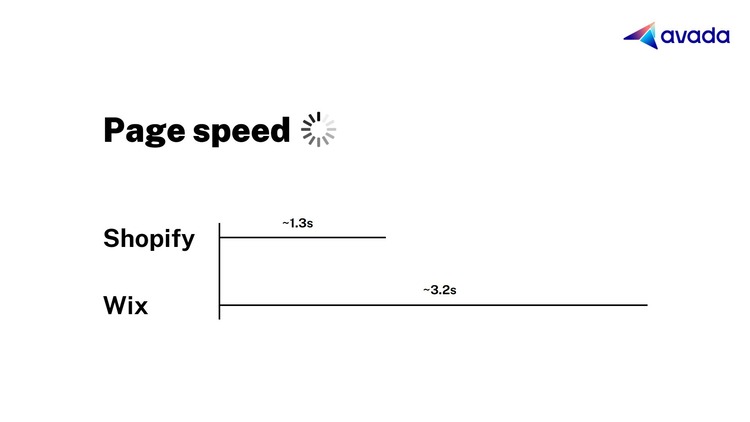
The verdict: Shopify has a slight edge because it has a much faster loading speed than Wix.
Third-party apps
Shopify and Wix both offer a range of third-party apps to enhance the functionality of their platforms. These apps cover a wide range of categories, including marketing, sales, shipping, social media, accounting, and more. Many of these apps are developed by third-party developers, and some are developed in-house by Shopify.
However, there are some key differences in the way they approach third-party app integration.
Shopify has a dedicated app store called the Shopify App Store, which currently offers over 8,000 apps.
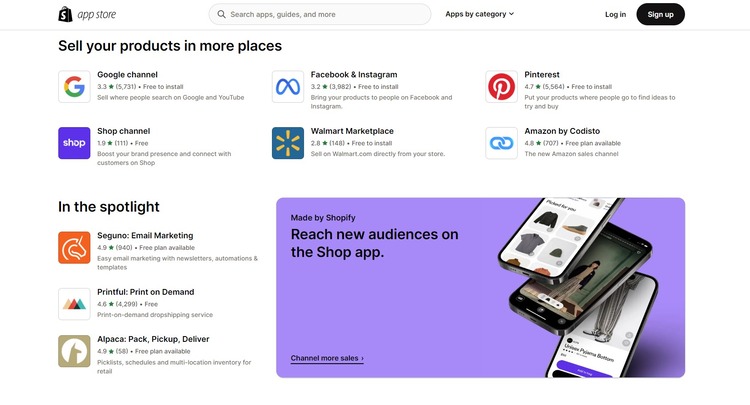
Wix also has a range of third-party apps available through its Wix App Market, which currently offers over 300 apps. Both Shopify and Wix also have an API that allows developers to create custom apps with the platform, however, Shopify makes it more attractive and easier for developers.
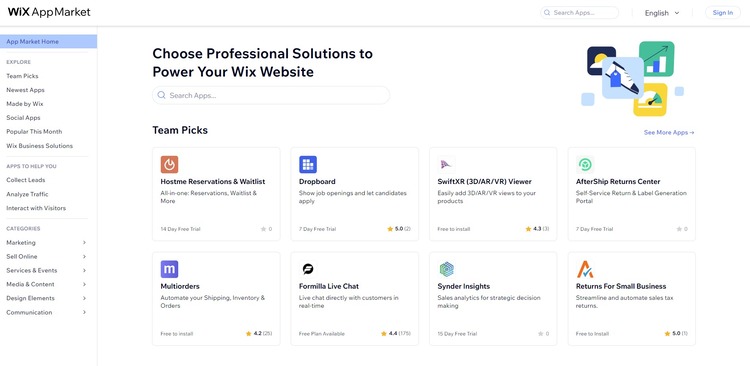
In terms of app quality and functionality, both platforms have some highly-rated and useful apps available. However, Shopify’s larger app store and more established API ecosystem give it an advantage in terms of app variety and customization options.
The verdict: Shopify is the winner because it offers a wider range of apps and customization options.
Security
Both Shopify and Wix offer various security features to ensure the safety and protection of their customers’ data. Here is a comparison of some of the security features of both platforms:
- SSL Encryption: Wix and Shopify provide SSL encryption to secure customer information and payment transactions.
- PCI DSS Compliance: Both platforms are PCI DSS compliant, which means they meet the Payment Card Industry Data Security Standard.
- Two-factor authentication: Both provide two-factor authentication as an optional security feature.
- Fraud prevention: Shopify has an advanced fraud prevention system that helps detect and prevent fraudulent transactions. Wix also provides fraud detection and prevention tools.
- Backups and disaster recovery: Both platforms offer automatic backups and disaster recovery solutions to ensure that data is safe and can be restored in case of any unexpected events.
- Server security: Both platforms use secure servers and follow industry-standard security practices to protect their customers’ data.
- App security: Shopify has a strict app review process to ensure that all apps available in the Shopify app store meet their security standards. Wix also performs regular security checks on their apps to ensure their safety.
Overall, both Shopify and Wix offer strong security features to protect their customers’ data.
The verdict: Shopify has a slight edge over Wix in terms of security.
Ease of Use
To see whether Shopify or Wix is easier to use, we have to look at these aspects:
#1. User Interface
Both Wix and Shopify have user-friendly interfaces that are easy to navigate. However, Shopify has a more intuitive dashboard that is specifically designed for ecommerce, while Wix has a more general website builder interface.
#2. Store Setup
Both platforms have a step-by-step setup process that guides users through setting up their online store. Shopify has a more streamlined setup process, making it faster to get started. Wix’s setup process is a bit more complex, as it is designed for building all types of websites, not just ecommerce.
#3. Customization
Both platforms offer a high degree of customization, allowing users to tailor their store’s design and functionality to their specific needs. Shopify offers more design options and more flexible customization, while Wix has a wider selection of pre-made templates.
#4. App Integration
Both platforms have app marketplaces that offer a variety of add-ons and apps to enhance store functionality. Shopify app store has a wider selection of third-party apps, while the Wix app market is still growing.
#5. Payment Processing
Both platforms offer easy payment processing options, including integration with multiple payment gateways. However, Shopify offers more built-in payment options than Wix.
The verdict: Shopify is easier for users to set up and manage their online store for its streamlined and intuitive interface for ecommerce.
Which is easier to use: Wix or Shopify?
Wix and Shopify are popular website builders for ecommerce, but when it comes to ease of use, Shopify has a slight advantage over Wix.
Here are some reasons why:
- Shopify has a more intuitive interface for ecommerce. It is designed specifically for online stores, whereas Wix is a more general website builder that can also be used for ecommerce.
- Shopify offers a wider range of ecommerce-specific features and tools, such as abandoned cart recovery, discount codes, and gift cards. These features are easy to set up and use, even for beginners.
- Shopify has a more robust app store with thousands of third-party apps and integrations. This means that you can easily add new features and functionality to your Shopify store without needing to know how to code.
That being said, Wix is still a user-friendly option for ecommerce, particularly for small businesses and those just starting out. It has a drag-and-drop interface that is easy to use, and its ecommerce tools are simple to set up.
Themes and Templates
Both Wix and Shopify offer a wide range of themes and templates to help businesses create their online stores quickly and easily. However, there are some differences between the two platforms when it comes to their theme and template features.
Shopify offers 111+ free themes and 11 paid themes, ranging from $180 to $350. These themes are designed to be responsive and customizable, allowing Shopify users to change colors, fonts, and layouts with ease. Each theme also comes with pre-built sections and templates for the homepage, product pages, and collections pages.
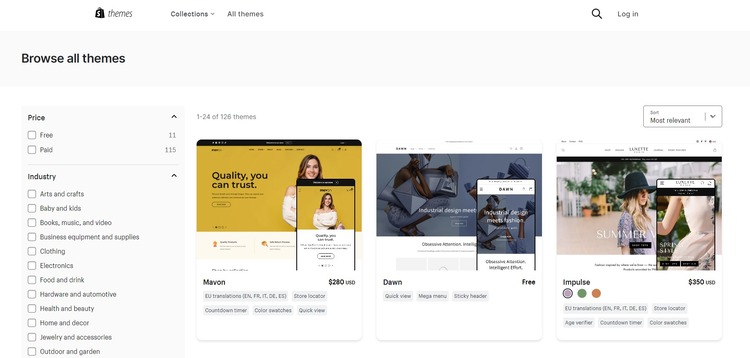
On the other hand, Wix offers 800+ customizable templates, including both ecommerce and non-ecommerce templates, free templates, and paid templates. Wix templates are also responsive and can be customized using their drag-and-drop editor. In addition, Wix has more design freedom than Shopify, allowing Wix users to place elements anywhere on the page.
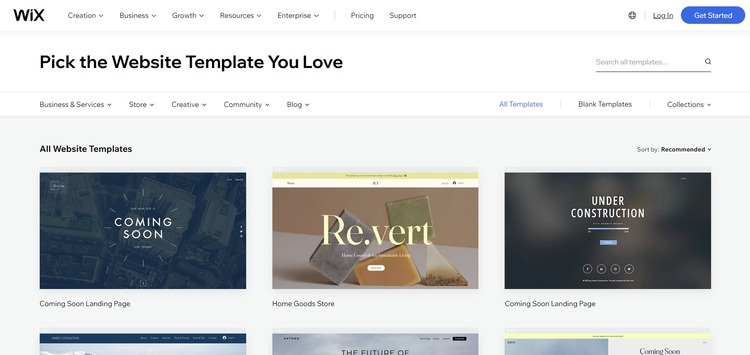
Both Shopify and Wix offer a countless number of third-party themes and templates for purchase.
In terms of design and customization options, Wix has a wider range of templates and more design freedom than Shopify. However, Shopify offers a more focused selection of themes specifically tailored for ecommerce, with built-in sections and templates for essential pages.
Furthermore, both platforms offer more flexibility in design.
When you create a new Wix website, you are prompted to choose between “Wix ADI” (Wix Artificial Design Intelligence) and “Wix Editor.” With the ADI, you simply answer a few questions regarding the purpose of your site and basic visual preferences—such as which font options and colors you prefer—and the Wix ADI designs your website for you. Meanwhile, Wix Editor lets you totally customize your Wix site.
Meanwhile, it’s easier to restyle and switch themes on Shopify than on Wix. The reason is that Shopify allows users to access the CSS and HTML code of the theme. So in the future, if you want to restyle the current theme or switch to another theme, you don’t have to rebuild it from scratch. Besides, unlike Wix, all Shopify themes are fully responsive for mobile devices., so you just need to create a desktop design for your Shopify store, and it will be automatically resized to suit the mobile version.
Unlike Shopify, Wix is more limited in re-designing with code. Plus, it uses pixels to design elements and is not as mobile responsive as Shopify. This requires us some extra effort to customize the appearance of our Wix store, both on desktop and mobile. When I designed my Wix site, I first thought that Wix would do the work on mobile for me until I realized that the mobile version wasn’t adjusted to the desktop. So I had to do the extra work, and it actually costs quite a lot of time (for a total beginner in design like me).
The verdict: Shopify wins over Wix for having more ecommerce-focused themes and templates.
Are Wix and Shopify themes mobile responsive?
The answer is: Shopify has mobile responsive templates and themes while Wix doesn’t. This means that themes on Shopify are designed to automatically adjust to different screen sizes and devices, ensuring that your Shopify site looks and functions properly on mobile phones and tablets. Meanwhile, on Wix you have to create 2 versions of your Wix website—one’s for desktop and the other for mobile.
Overall winner
While both Shopify and Wix offer a range of features and tools for building an online store, Shopify comes out on top in terms of pricing, sales features, dropshipping, help and support, page speed, third-party apps, security, and themes and templates. Wix does offer some advantages, such as a built-in dropshipping app and a slightly lower starting price point, but Shopify’s overall range and quality of features make it the winner for building an online store.
Shopify vs Wix: FAQs
Is it better to use Wix or Shopify?
Wix and Shopify are popular ecommerce platforms with their own set of advantages and disadvantages. Wix is a more beginner-friendly platform, with easy-to-use drag-and-drop tools for website building, while Shopify is more advanced and designed for ecommerce businesses of all sizes. Ultimately, which platform to choose depends on the specific needs of your business and your budget.
Can I use Wix for Shopify?
No, Wix and Shopify are separate ecommerce platforms and cannot be used together. However, you can migrate your online store from Wix to Shopify or vice versa.
Can I code on Shopify and Wix?
Yes, Wix and Shopify allow for customization through coding. Shopify uses its own coding language, Liquid, while Wix uses HTML and CSS.
Which is better for selling in multiple currencies, Wix or Shopify?
Shopify is better equipped for selling in multiple currencies with its built-in multi-currency feature, which allows merchants to display prices and receive payments in different currencies. Wix, on the other hand, does not have a built-in multi-currency feature and requires the use of a third-party app.
Can I use Shopify with Wix?
No, Shopify and Wix are separate ecommerce platforms and cannot be used together. However, you can migrate your online store from Wix to Shopify or vice versa.
What are alternatives to Wix and Shopify?
When it comes to building an ecommerce website, Wix and Shopify are two popular options, but they are not the only ones. Here are some alternatives to consider:
- Weebly: Weebly is a drag-and-drop website builder that offers ecommerce functionality. It has a variety of templates to choose from and is known for its ease of use.
- WordPress: WordPress is a popular content management system that can also be used for ecommerce. It offers a wide range of plugins and themes to customize your site but may require more technical knowledge to set up.
- Squarespace: Squarespace is a website builder that offers a range of features including ecommerce functionality. It is known for its sleek and modern designs.
- GoDaddy: GoDaddy is a website builder and hosting service that offers ecommerce functionality. It has a user-friendly interface and offers a variety of templates to choose from.
- Etsy: Etsy is an online marketplace that allows sellers to create their own online store within the platform. It is popular for handmade and vintage items.
- Big Cartel: Big Cartel is an ecommerce platform that caters to independent artists and makers. It offers a range of features to help artists sell their products online.
- Ecwid: Ecwid is an ecommerce platform that can be integrated with existing websites or social media pages. It offers a variety of features including mobile responsiveness and multilingual support.
Each of these platforms has its own strengths and weaknesses, so it’s important to consider your specific needs when choosing the best option for your ecommerce store.
Shopify vs Wix: Conclusion
In conclusion, Shopify and Wix are both powerful ecommerce platforms that offer a range of features to help users build and run their online stores. When it comes to specific features, such as shipping and taxes, Wix may have some advantages, while Shopify may be stronger in areas like SEO and app integrations. However, ultimately the choice between Shopify and Wix will depend on the individual needs and preferences of the user.
Both Shopify and Wix are powerful ecommerce platforms with their own unique features and benefits. Shopify is better for businesses focused solely on ecommerce, while Wix is better for businesses that require more flexibility in website design and content management. Ultimately, the choice between the two depends on the specific needs and goals of your business.
Who should use Shopify? And who should use Wix?
Shopify is a better option for:
- Businesses with larger budgets and a need for advanced ecommerce features
- Businesses looking for scalability and flexibility
- Businesses with a focus on international sales and a need for multiple payment gateways
Wix is a better option for:
- Small businesses or individuals with a limited budget and basic ecommerce needs
- Businesses with a focus on design and branding





